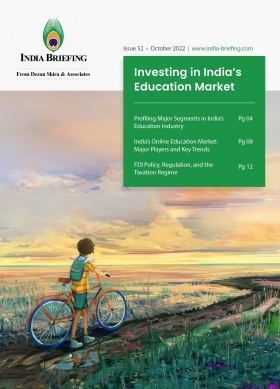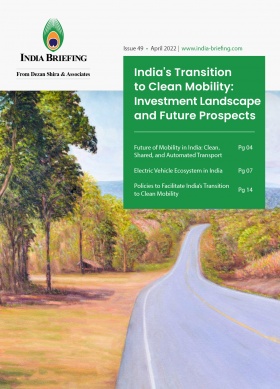India’s Leading Export Destinations: Trends and 2023 Outlook
India’s exports have soared in the past two years on the back of robust manufacturing and an enabling policy landscape. While India’s merchandise exports registered a record high of US$417.81 billion in FY 2022, the government estimates that India will achieve an export target of US$450 billion during FY 2023. Additionally, despite the fact that the world economy is expected to slow down amidst the ongoing global headwinds and the resulting supply chain disruptions, India will only see a minor impact, avoiding a large one because of its robust domestic market and recent free trade deals with Australia and the UAE. In this article, we examine the major trends affecting India’s export industry, and list India’s leading export destinations for FY 2023.
Over the past few years, exports from India have soared tremendously on the back of robust manufacturing in several sectors and an enabling policy landscape. In the financial year (FY) 2022, India’s merchandise exports soared to a record high of US$417.81 billion, surpassing the government’s target of US$400 billion. The export growth was mainly driven by a surge in demand for products like petroleum, cotton yarn, textiles, chemicals, and engineering goods. The government estimates that India will achieve an export target of US$450 billion during FY 2023.
During FY 2023 (April-November 2022), exports stood at US$295.26 billion, compared to US$265.77 billion in the same period last year, recording a growth of 11 percent.
As per a recent report by the economic think tank Global Trade Research Initiative (GTRI), India is set to achieve the highest ever export turnover in calendar year (CY) 2022. Its total merchandise and services export turnover will be in the range of US$740-750 billion. Merchandise exports are expected to be in the range of US$440–450 billion, while service exports are expected to be in the range of US$295–300 billion in CY 2022, as compared to US$254 billion in CY 2021.
India’s leading export destinations: Netherlands and Brazil leapfrog ahead in FY 2023
The US, UAE, Netherlands, China, Bangladesh, Singapore, Brazil, UK, Saudi Arabia, Indonesia, Germany, Hong Kong, etc. are among India’s leading export destinations.
During the April-November 2022 period, the Netherlands and Brazil leaped ahead of their previous positions on India’s list of export destinations. While the Netherlands is now India’s third-largest export destination, Brazil, which was India’s 20th largest export destination between April and October 2021, is currently in the eighth position.
The US and UAE maintained their top positions during the first eight months of FY 2023, and Indian exports also saw a diversified basket of goods and have expanded into non-traditional markets like Africa, Latin America, and the Oceania region.
The ongoing fiscal saw a threefold increase in exports from India to the African nation of Tanzania, mainly on account of petroleum and diesel.
What constitutes India’s export basket?
In terms of the export basket, while India’s total exports rose 12.5 percent to over US$263 billion during April-November 2022, oil product exports soared by around 70 percent. This is mainly because while several countries have reduced their dependence on Russia-refined oil products, India, which has seen a sharp spike in crude imported from Russia, is seen to be processing it and exporting it to many countries, especially in Europe.
Major items that dominated India’s export basket in FY 2022 include gems and jewelry (16 percent of total shipments), mineral fuels, oils and waxes, and bituminous substances (12 percent); vehicles, parts, and accessories (five percent); nuclear reactors, boilers, machinery, and mechanical appliances (five percent); pharmaceutical products (five percent); and organic chemicals (four percent), etc.
Future outlook for Indian exports: Global headwinds might cause moderate slump, FTAs to boost India’s exports
According to Santosh Kumar Sarangi (Director General of Foreign Trade (DGFT)), Indian merchandise exports are likely to maintain “similar or higher levels” in FY 2024, despite global recessionary trends. According to the DGFT, India’s recently signed free-trade agreements (FTAs) with the UAE and Australia are expected to provide a boost to exports in the next fiscal.
The India-Australia Economic Cooperation and Trade Agreement (ECTA) officially came into effect on December 29, 2022, while the India-UAE Comprehensive Economic Partnership Agreement (CEPA) entered into force in May 2022. They aim to boost bilateral trade to US$50 billion and US$100 billion, respectively, within the next five years.
Additionally, India is also in the midst of negotiating FTAs with the UK, the European Union (EU), Israel, and other countries.
The GTRI report hints at a moderate slump in Indian exports in the upcoming fiscal year due to weak global demand and a recession in large economies. According to the think tank, with the US’ effort to create alternate supply chains that do not include China, India is well-positioned to benefit from supply chain restructuring and has recently seen many large manufacturing firms relocate from China to India.
Factors driving export growth in India
Export promotion measures by the government
- Foreign Trade Policy (FTP): The FTP 2015-20, originally scheduled to expire on March 31, 2021, has been repeatedly extended; initially because of the COVID-19 epidemic and more recently because of “volatile” geopolitical and economic trends brought on by the conflict between Russia and Ukraine. Currently set to expire on March 31, 2023, FTP 2015-20 is anticipated to be replaced by the new FTP around that time. The new FTP, according to DGFT, “envisages outlining the roadmap for attaining US$2 trillion in exports (goods and services) by 2030. It would also concentrate on a variety of other new and developing trade-related fields, such as exports from e-commerce.
- Interest equalization scheme (IES) on pre and post shipment rupee export credit: This scheme has been extended up to March 31, 2024. Under this scheme, an eligible exporter has to submit a certification of the external auditor to the concerned bank to claim this benefit. Banks provide IES benefits to the eligible exporters and claim a reimbursement from the Reserve Bank of India (RBI) based on the external auditor certification furnished by the exporter. The scheme helps the identified export sectors to be internationally competitive and to achieve a higher level of export performance.
- Trade Infrastructure for Export Scheme (TIES): This scheme aims to assist Federal and State government agencies in the creation of appropriate infrastructure for the growth of exports. The scheme can be availed by States through their implementing agencies, for infrastructure projects with significant export linkages like border haats, land customs stations, quality testing and certification labs, cold chains, trade promotion centres, export warehousing and packaging, special economic zones (SEZs) and ports/airports cargo terminuses.
- Market Access Initiatives (MAI) scheme: It is an export promotion scheme envisaged to act as a catalyst to promote India’s exports on a sustained basis. The scheme is formulated on focus product-focus country approach to evolve specific market and specific product through market studies/survey.
- Rebate of State and Central Levies and Taxes (RoSCTL) scheme: This scheme has been implemented since March, 2019 to promote labour oriented textile export.
- Remission of Duties and Taxes on Exported Products (RoDTEP) scheme: This scheme has been implemented since January 2021 with an outlay of INR 124.54 billion (US$1.68 billion). It is a tax neutralization scheme which will refund the central, state, and local duties or taxes to exporters who do not benefiting from pre-existing rebates or refund schemes. This scheme replaces the previous Merchandise Export from India Scheme (MEIS), which was not considered compliant with World Trade Organization (WTO) rules.
- Common Digital Platform for Certificate of Origin (CoI): The common digital platform is a single point access for certificates of origin for all FTAs and preferential trade agreements (PTAs) for all agencies and all products. It is designed to facilitate exporters through a secure, electronic, paperless CoI issuance process. All designated CoI issuing agencies are required to work through this portal.
- Champion service sectors: Identification of 12 champion services sectors for promoting and diversifying services exports by pursuing specific action plans. These include information technology (IT) and information technology enabled services (ITES), tourism and hospitality services, medical value travel, transport and logistics services, accounting and finance services, audio visual services, legal services, communication services, construction and related engineering services, environmental services, financial services and education services.
- Districts as export hubs: Under this initiative, products and services (including GI products, agricultural clusters, toy clusters etc.) with export potential are identified in all districts of the country. Districts Export Action Plans are prepared for identified products and services for overseas markets, which includes specific actions required to support local exporters / manufacturers in producing/manufacturing identified products in adequate quantity and requisite quality, for reaching potential buyers outside India. These plans also include identifying and addressing challenges for exports of such identified products/services, improving supply chains, market accessibility and handholding for increasing exports.
- Relief packages announced in light of the COVID-19 pandemic to support domestic industry through various banking and financial sector relief measures, especially for MSMEs, which constitute a major share in exports.
Production-linked incentive (PLI) scheme
To develop India into a global manufacturing hub and speed up job creation, the government has rolled out PLI schemes in 14 sectors since 2020, with incentives amounting to INR 1.97 trillion (US$23.81 billion). The scheme, which is in tune with the “Make in India” program, is intended to boost domestic manufacturing and simultaneously catapult India’s export sector.
National Logistics Policy (NLP)
To make Indian exports globally more competitive, India also recently released the National Logistics Policy, which provides for the seamless integration of multiple modes of transportation by leveraging technology, processes, and skilled manpower. The policy, which is in line with PM GatiShakti National Master Plan, will give a massive boost to India’s US$200 billion logistics sector, thereby enabling smooth movement of goods both domestically and internationally.
Foreign Direct Investment (FDI) policy
Within the ambit of this policy, the federal government has approved 100 percent FDI under an automatic route in many sectors in order to give a thrust to Indian exports.
About Us
India Briefing is produced by Dezan Shira & Associates. The firm assists foreign investors throughout Asia from offices across the world, including in Delhi and Mumbai. Readers may write to india@dezshira.com for more support on doing business in in India.
We also maintain offices or have alliance partners assisting foreign investors in Indonesia, Singapore, Vietnam, Philippines, Malaysia, Thailand, Italy, Germany, and the United States, in addition to practices in Bangladesh and Russia.
- Previous Article Gujarat and Rajasthan Emerge as India’s Leading Investment Destinations
- Next Article India to Surpass China’s Population in 2023: Here’s Why That Matters

















